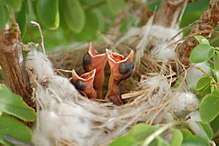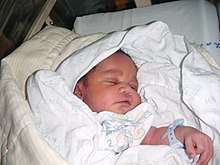Altriciality
In biology, altricial species are those in which the young are incapable of moving around on their own soon after hatching or being born.

The word is derived from the Latin root alere, meaning "to nurse, to rear, or to nourish" and indicates the need for young to be fed and taken care of for a long duration.[1] By contrast, species whose young are immediately or quickly mobile are called precocial.
Scope

In bird and mammal biology, altricial species are those species whose newly hatched or born young are relatively immobile, lack hair or down, are not able to obtain food on their own, and must be cared for by adults; closed eyes are common, though not ubiquitous. Altricial young are born helpless and require care for a length of time. Altricial birds include herons, hawks, woodpeckers, owls, cuckoos and most passerines. Among mammals, marsupials and most rodents are altricial. Domestic cats, dogs, and humans are some of the best-known altricial organisms.[2] For example, newborn domestic cats cannot see, hear, maintain their own body temperature, or gag, and require external stimulation to defecate and urinate.[3] The giant panda is notably the largest placental mammal to have altricial, hairless young upon birth. The larvae of some insects and other invertebrates such as scorpions may be considered altricial as well. In particular, the larvae of eusocial insects such as ants, bees, and wasps are immobile and helpless grubs that are completely dependent on the workers tending to them.
At the opposite end of the spectrum are precocial animals in which the young have open eyes, have hair or down, have large brains, and are immediately mobile and somewhat able to flee from, or defend themselves against, predators. For example, with ground-nesting birds such as ducks or turkeys, the young are ready to leave the nest in one or two days. Among mammals, most ungulates are precocial, being able to walk almost immediately after birth. Beyond the precocial are the superprecocial animals, such as the megapode birds, which hatch with full flight feathers.[4]
Basis
Different animals employ different precocial and altricial strategies; there is no clear distinction between the two states, and a wide range of intermediate states.[1] The ability of the parents to obtain nutrition and contribute to the pre-natal and post-natal development of their young appears to be associated.
Precocial birds are able to provide protein-rich eggs and thus their young hatch in the fledgling stage – able to protect themselves from predators and the females have less post-natal involvement. Altricial birds are less able to contribute nutrients in the pre-natal stage; their eggs are smaller and their young still in need of much attention and protection from predators. This may be related to r/K selection; however, this association fails with a number of cases.[5]
In birds, altricial young usually grow faster than precocial young. This is hypothesized to occur so that exposure to predators during the nestling stage of development can be minimized.[6]
In the case of mammals it has been suggested that large adult body sizes favor production of large, precocious young, which develop with a long gestation period. Large young may be associated with long lifespan, extended reproductive period, and reduced litter size. It has been suggested that altricial strategies in mammals may be favoured if there is a selective advantage to mothers that are capable of resorbing embryos in early stages of development.[7] Some ecological niches require young to be precocial for survival, such as cetaceans: restricted to water, and immobile, their helpless young would quickly drown.
Terminology
In birds, the terms Aves altrices and Aves precoces was introduced by Carl Jakob Sundevall (1836) and the terms nidifugous and nidicolous by Lorenz Oken in 1816. The two classifications were considered identical in early times, but the meanings are slightly different, in that "altricial" and "precocial" refer to developmental stage, while "nidifugous" and "nidicolous" refer to leaving or staying at the nest.[5]
The two strategies result in different brain sizes of the newborns compared to adults. Precocial animals' brains are large at birth relative to their body size, hence their ability to fend for themselves. However, as adults, their brains are not much bigger or more able. Altricial animals' brains are relatively small at birth, thus their need for care and protection, but their brains continue to grow. As adults, altricial animals end up with comparatively larger brains than their precocial counterparts. Thus the altricial species have a wider skill set at maturity.[1]
See also
References
- Ehrlich, Paul (1988). The Birder's Handbook. New York: Simon & Schuster. ISBN 0-671-65989-8.
- Arterberry, Martha E. (2000). The Cradle of Knowledge. Development of Perception in Infancy. Cambridge: MIT Press. p. 27. ISBN 9780262611527.
- Hannah Shaw. "Determining a Kitten's Age".
- Starck, J.M.; Ricklefs, R.E. (1998). Avian Growth and Development. Evolution within the altricial precocial spectrum. New York: Oxford University Press. ISBN 0-19-510608-3.
- Starck, J. (1998). Avian Growth and Development. Oxford Oxfordshire: Oxford University Press. ISBN 0-19-510608-3.
- Kahl, M. Philip (1962). "Bioenergetics of growth in nestling wood storks". The Condor. 64 (3): 169–183. doi:10.2307/1365200. ISSN 0010-5422.
- Eisenberg, John (1981). The Mammalian Radiations. London: Athlone Press. ISBN 0-485-30008-7.